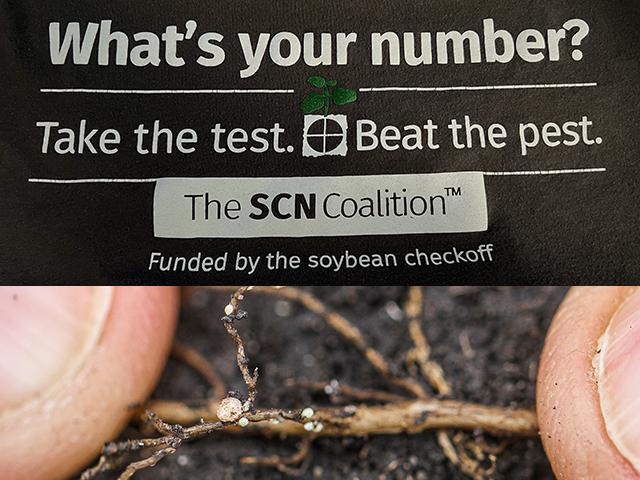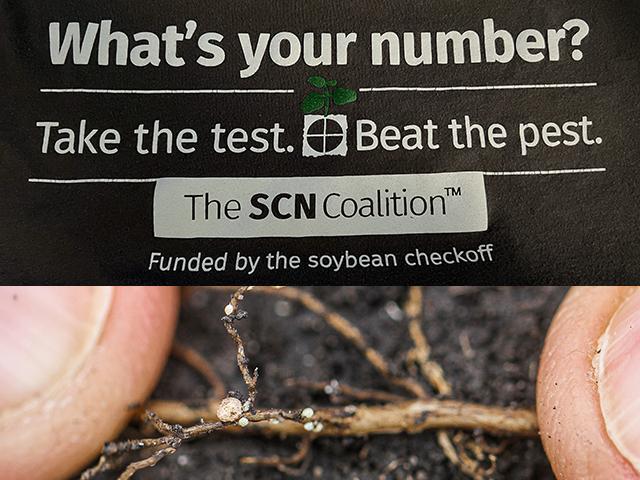Production Blog
Start Digging for Soybean Yield Loss Answers
I was in the grocery store produce aisle when I heard shouting.
"I'm a 4! I'm a 4! I'm a 4! ..."
It took a moment before I realized the ruckus was aimed at me. A man slid to a stop before me and once again said: "I'm a 4!"
Then, he stood with his hands on hips expectantly. Other shoppers stared. I swear, even the heads of the cabbage, lettuce and cauliflower turned to look. The sweet corn was all ears.
He pointed to my T-shirt and read aloud: "Know your number. Take the test. Beat the pest." A slow reality set in. This T-shirt is a treasure from a 2022 soybean cyst nematode (SCN) conference. I wear it a lot because I like it and well ... it's got a soybean plant imprinted on it with wee nematode on the root. People frequently assume I have dropped something on my shirt and wearing it makes me mostly innocent of the charge.
Granted, this fellow probably wasn't expecting an agronomy class when he issued his "4 challenge," but ag folks seldom pass on an opportunity to educate. When he proceeded to ask again if "4" was the right number, I explained the why behind the T-shirt, and he got a Cliff Notes speech about SCN.
He listened intently and responded: "I had no idea soybeans were so complicated. Apparently '4' isn't the right answer." Then, he turned and walked away. End of story -- except I couldn't quit thinking about it.
People often ask what topic I've written about the most in my career and SCN would be a good guess. One of my first assignments was to tag along with an Extension plant pathologist to pull soil samples looking for the pest -- as I recall, we documented Race 5 in Illinois from that trip to the field. In the years since, rafts of research have been conducted and progress has been made introducing commercial SCN-resistant varieties. Crop protection companies have brought forward nematicides. More sophisticated HG-type testing is showing how SCN can reproduce on different sources of SCN resistance.
The SCN Coalition, a public/checkoff/private partnership, has been doing their darndest to increase the number of soybean growers actively managing SCN. Led by Iowa State University plant pathologist Greg Tylka, the group does a thorough job of getting the word out regarding the economic realities of the pest.
Still, this one weird, random encounter in the grocery store keeps gnawing at me. Why do farmers drag their feet when it comes to testing for SCN?
P[L1] D[0x0] M[300x250] OOP[F] ADUNIT[] T[]
Most soybean producers have heard of SCN and seem to understand it is the nation's leading yield-reducing pathogen of soybean. The SCN Coalition surveys have recorded an uptick in farmers managing SCN through resistant varieties and crop rotation.
Part of the problem is that much like herbicide resistance, 20-plus years of depending on a single set of resistance genes, from the breeding line PI 88788, has compromised the easy button. Reproduction of SCN populations in infested fields is no longer effectively suppressed by soybean varieties containing PI 88788. Tylka has stated that populations in some Iowa fields are now almost completely uncontrolled by PI 88788 resistance.
A recent release from a study in Illinois conducted from 2018 to 2020 showed over one-third of the acres in the state are likely losing yield each season due to this pest. The report indicated widespread prevalence of populations with elevated reproduction on PI 88788 derived resistance. The good news is this Illinois-based study found 50% to 70% control with PI88788 during their sampling period. Read the study here: https://illinois.us13.list-manage.com/….
Still, how many farmers would be happy with that kind of efficacy from an input selected to control other pests?
Seed companies have answered these looming concerns by beginning to increase the number of varieties offering alternative resistance called Peking. But there's already concern about overplanting Peking and that nematodes could overcome it at a much faster rate than PI 8878. Read more about that here: https://www.dtnpf.com/….
FOUR DIGGING TIPS
So, no, the correct answer is not 4. Iowa State University considers egg counts of less than 2,000 per 100 cc of soil to be low and numbers above 12,000 eggs to be high. But those figures vary by state, Tylka said.
What makes SCN more challenging is the crop doesn't give much in the way of above-ground symptoms until the situation is critical.
However, digging this time of year does offer an early first look at whether the tools you are using to control SCN are working.
It takes from four to six weeks after planting for SCN females initially to appear on the root surface, according to a recent Iowa State University release. Read it here: https://crops.extension.iastate.edu/….
That means the first SCN females of 2023 should be visible now or soon, and additional adult females will appear on infected roots for the remainder of the growing season.
Four tips for doing an in-season dig as recommended by The SCN Coalition include:
1. Grab a shovel or a spade and dig at least 8 inches deep to remove the smaller, younger roots on which SCN females are found. Dig up the entire plant. Do not pull the plant from the soil, or you might dislodge the tiny, white SCN females.
2. Look at the roots closely for little white granules -- much like grains of salt or sugar. They will be about one-tenth the size of the healthy nitrogen-fixing nodules that should also be present.
3. Take a closer look. Carefully wash off the soil. Place the roots against something black or use a hand lens for magnification. These little specks are SCN females waiting to give birth to another generation -- all the while feeding on soybean roots and sucking the life out of potential yield.
4. Prepare to test this fall. Finding females means you need to determine the SCN numbers in your fields and plan a management strategy.
This year brings an added urgency. Drought years are known to add to the SCN problem. "We have data verifying that SCN is worse in hot, dry years," Tylka told me in 2020. "It's not just because plants are stressed from drought, but also because the nematode is reproducing much quicker, raising population densities." Read more about that here: https://www.dtnpf.com/….
Perhaps I need to edit my SCN T-shirt to include another popular motto. When it comes to testing for this pest: JUST DO IT!
Pamela Smith can be reached at pamela.smith@dtn.com
Follow her on Twitter @PamSmithDTN
Pamela Smith can be reached at pamela.smith@dtn.com
Follow her on Twitter @PamSmithDTN
(c) Copyright 2023 DTN, LLC. All rights reserved.






Comments
To comment, please Log In or Join our Community .